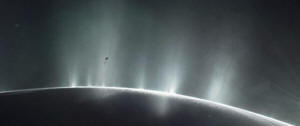|
Hydrogen in Saturn moon's ice plumes may
support microbial life
 Send a link to a friend
Send a link to a friend
 [April 14, 2017]
By Irene Klotz [April 14, 2017]
By Irene Klotz
(Reuters) - Ice plumes shooting into space
from Saturn's ocean-bearing moon Enceladus contain hydrogen from
hydrothermal vents, an environment that some scientists believe led to
the rise of life on Earth, research published on Thursday showed.
The discovery makes Enceladus the only place beyond Earth where
scientists have found direct evidence of a possible energy source for
life, according to the findings in the journal Science.
Similar conditions, in which hot rocks meet ocean water, may have been
the cradle for the appearance of microbial life on Earth more than 4
billion years ago.
"If correct, this observation has fundamental implications for the
possibility of life on Enceladus," geochemist Jeffrey Seewald, of the
Woods Hole Oceanographic Institution in Massachusetts, wrote in a
related commentary in Science.

The discovery was made using NASA's Cassini spacecraft, which in
September will end a 13-year mission exploring Saturn and its entourage
of 62 known moons.
The detection of molecular hydrogen occurred in October 2015 during
Cassini's last pass through Enceladus' plumes, when it skimmed 30 miles
(49 km) above the moon's southern pole taking samples.
In 2005, Cassini discovered Enceladus's geysers, which shoot hundreds of
miles into space. Some of the material falls back onto the surface as a
fresh coat of ice, while much of the rest gathers into a halo of ice
dust that feeds one of Saturn's rings.
A decade later, scientists measuring the moon's slightly wobbly orbit
around Saturn determined it holds a vast ocean buried 19- to 25 miles
(30- to 40 km) beneath its icy shell. The ocean is believed to be the
geysers' source.
[to top of second column] |

NASA's Cassini spacecraft is shown diving through the plume of
Saturn's moon Enceladus, in 2015, in this photo illustration.
NASA/JPL-Caltech/Handout via REUTERS

Several moons orbiting Jupiter and Saturn are known to contain
underground oceans, but Enceladus is the only one where scientists
have found proof of an energy source for life.
"We're moving toward Enceladus's ocean being habitable, but we're
not making any claims at this point about it being inhabited," lead
author Hunter Waite, with the Southwest Research Institute in San
Antonio, Texas, said in an interview.
"The next time we go back ... you're going to take something that
not only picks up on the habitability story, but it starts looking
for evidence for life."
Enceladus has a diameter of 310 miles (500 km) and is one of
Saturn's innermost moons. The heat needed to keep its ocean from
freezing is thought to come from tidal forces exerted by Saturn and
a neighboring larger moon, Dione.
(Reporting by Irene Klotz in Fort Lauderdale, Fla.; Editing by
Daniel Wallis and Bernadette Baum)
[© 2017 Thomson Reuters. All rights
reserved.]
Copyright 2017 Reuters. All rights reserved. This material may not be published,
broadcast, rewritten or redistributed.
 |